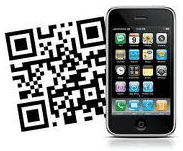A few weeks ago our Gen Y-er went to the Good Food and Wine Show in Sydney. It was more an exercise of “pretend to look interested to get free wine samples”, but she had a good time anyway.
While stumbling around the convention centre, she came across a few wineries that were using QR (Quick Response) codes on all their labels. With a quick scan you access info inc grape variety, tasting and wine making notes, pictures of where the grape was grown, food pairings and much more. Would she be more likely to buy a wine that had a QR reader? You bet. Would she have searched for the winery on Facebook or their website to get this information? No way.
QR codes are expected to achieve widespread use this year and having a website will no longer be enough.
QR codes give people immediate access to what’s relevant to what they’re doing right that second. People are more open to using apps and mobile devices for everyday transactions as they become more comfortable with their online and offline worlds colliding. They instantly connect a person’s real world with the brand’s online world.
Although QR codes are relatively new here, they’ve been around in Japan for almost a decade and a few years in the states. They’re being used for a range of products and services – from New York City building permits, to have people support a cause or sign a petition (like in the “Restore the Gulf” campaign in response to the BP oil spill) and even edible QR codes at restaurants. Calvin Klein replaced their billboards with them last year.
We can think of hundreds of way we would use QR codes in our everyday life. Apart from wine, QR codes could be used on food to show a consumer how it was sourced, complimentary products, recipe ideas, if the brand supports a cause it can link to their giving page. Cosmetic companies could link to information on other products, links to “how to” videos, enticing someone to consider buying another product. In print ads to link the customer and engage them on another medium. On your business cards. Think about how many products and ads you come across in a day, and that is an opportunity to be enticed online quickly and easily.
So, should you jump on the QR code bandwagon? Short answer is yes. We’re a bit geeky at our HQ and we love anything new, but increasingly so does everyone else. Smart phones are greatly outselling any other type of phone and sales of tablets have surged in Australia the first half of this year. It’s important that marketers and businesses keep up with trends in technology.
Basically you only need a few things to make your QR tactic work.
a) A QR code. These are relatively painless to create. Check out myQR.co, which has an analytics functions, but a quick search will help you find the right one.
b) A customer with a smart phone and QR reader (which are free to download)
c) Most importantly, compelling reason for QR Codes to be used that your potential customers will be willing to scan. You have to offer them something they don’t get when browsing for or experiencing your product.
From a marketing perspective it’s a way to add value and enhance your customer experience, and connect to your audience instantly on another level. However remember that it’s important to treat it like any other marketing tactic- ensure it makes sense for your business, what your goal is (it could be to collect leads, enhance the customer experience, offer discounts, promotions or special offers, offer additional content, guidance, education, or just for fun), test it, and if it’s not delivering, rethink your approach.
Have you introduced QR codes into your marketing plan? How did it work for you?

